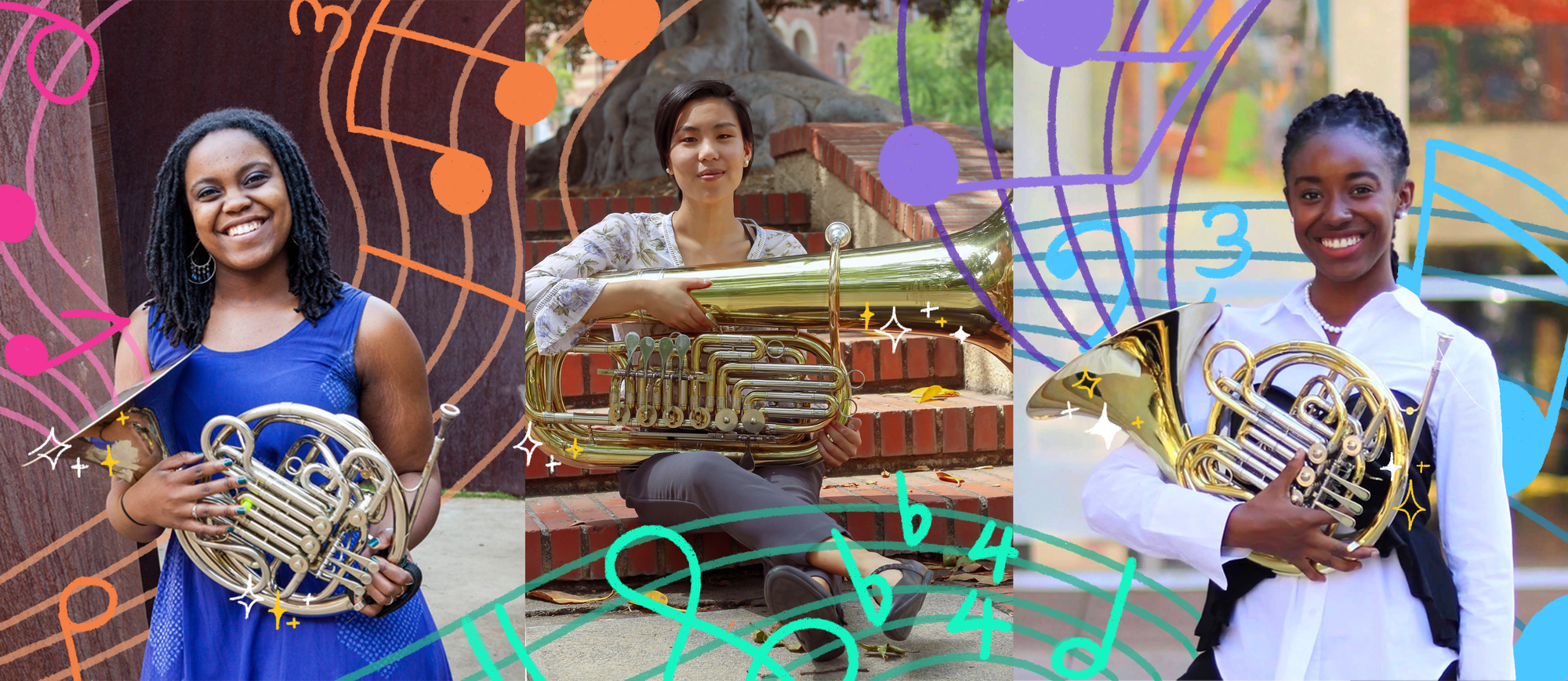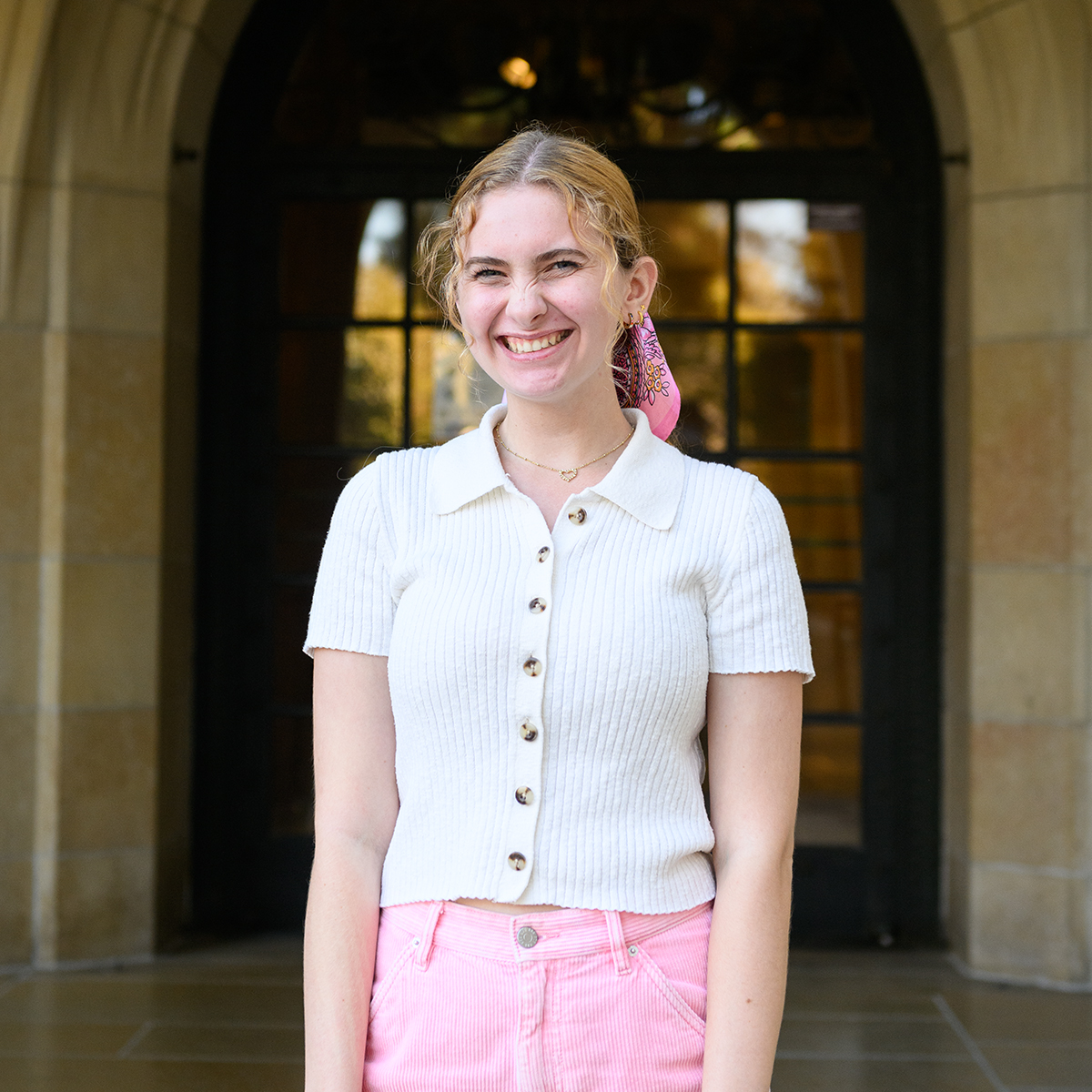Chromatic Brass Collective shines as beacon of inclusivity within classical music

Alumnus and co-founder Yasmeen Richards (left) serves as the President of the Chromatic Brass Collective alongside co-founder, Vice President of Operations and fourth-year French horn performance student Madison Dorsett (right). For alumnus and member Vivian Kung (center), the brass collective’s mission focuses on uplifting underrepresented musicians and their work. (From left to right: Photo courtesy of Susan Capra, courtesy of Cristina Cutts, courtesy of Travis J. Cross. Photo Illustration by Dani Nalangan/Daily Bruin)

By Abigail Siatkowski
Oct. 17, 2021 11:01 p.m.
This post was updated Oct. 22 at 11:39 a.m.
The Chromatic Brass Collective is making sure to hit every note.
The collective got its start in June 2020 when a group of musicians gathered to discuss their experiences as Black women and Black femmes in classical music, said alumnus Yasmeen Richards, who serves as the president and co-founder of the Chromatic Brass Collective. Since then, Richards said the organization has made it its mission to expand the idea of what a brass player looks like.
“(A brass player is) not always a man, it’s not always a white person,” Richards said. “The first thing would just be taking up more space and taking our space to define who we are.”
In classical music, the composers whose music is stereotypically played are usually white, male and heterosexual, said Madison Dorsett, a fourth-year French horn performance student. The Chromatic Brass Collective wants to change the type of musician people imagine when they think of the genre, said the co-founder and vice president of operations.
[Related: ‘Modern Beauty’ music series hopes to engage audience with themes of versatility]
The name Chromatic Brass comes from the term chromatic scale, Dorsett said, which refers to a scale in which all the notes used in Western music are played. For Dorsett, the title fits the collective because of its mission to represent all people in brass music.
“If you think about it in a visual arts perspective, chromatic means all the colors and so I was like, ‘That’s kind of what we are,'” Dorsett said. “We’re all the colors, all the notes, all the peoples.”
After the conversation in June, Richards said the idea to make the group into something more structured occurred to all involved. For a few months, the organization was less active, but Richards said she reignited the spark in fall 2020 and began building the foundation of the collective, making a logo and figuring out logistics. At the time, she was dealing with the loss of one of her private students, and she said pouring herself into the Chromatic Brass Collective allowed her to find a sense of direction.
Now, Richards said she looks forward to expanding the group’s endeavors. Vivian Kung, an alumnus and member of the Chromatic Brass Collective, said a large portion of the collective’s work centers around uplifting the accomplishments of underrepresented musicians. This includes playing compositions written by Black women and putting together video shows featuring only female and gender non-conforming artists, Kung said.
Thus far, performances have included the collective’s debut concert in June 2021 and videos featured at the International Horn Symposium in August, which was particularly important because of the conference’s influential status, Kung said. This coming May, Richards said 27 of the collective’s musicians will also participate in the International Women’s Brass Conference in Dallas-Fort Worth, Texas. The Chromatic Brass Collective will make sure those who attend on its behalf will receive stipends, Dorsett said, because women in orchestras often do not receive proper compensation.
Aside from increasing representation, Dorsett said another one of the Chromatic Brass Collective’s goals is to provide resources for music students. Instruments can be expensive and are often inaccessible to female musicians of color, Dorsett said. Growing up, Dorsett could not afford private lessons or her own instruments and said she was only able to participate in music through her school.
“One of our missions is to be … a source of education and an opportunity to provide resources for interested students,” Dorsett said.
The Chromatic Brass Collective also aims to provide mentorship opportunities, Richards said. The collective hopes to fund a graduated mentorship program, through which she said members of the Chromatic Brass Collective can receive guidance from older musicians and also teach children. She said she hopes that such a program will bring together the older musician, the Chromatic Brass Collective member and the young student for conversations.
“There’s no hierarchy in that way,” Richards said. “Because that was a big thing that we wanted to address.”
[Related: Professor’s concert series offers harmony in the discordant world of COVID-19]
For Kung, the Chromatic Brass Collective provided the opportunity to learn from Velvet Brown, a well-known Black tuba player. With the group, Kung said Brown discussed not only the experiences of a professional musician but also what it is like to be a Black woman in the world of classical music.
Despite the work it has done so far, one of Chromatic Brass Collective’s greatest challenges right now is finding the funding for its initiatives, Richards said. The collective is currently working to achieve nonprofit status, but Richards said the paperwork has yet to be approved. The collective has held a fundraiser via Fractured Atlas, an organization that facilitates acceptance of donations for organizations that are not nonprofits, Richards said.
“Fundraising is a lot more difficult than I would have ever known, ever,” Richards said. “It is so much work beyond bake sales.”
But when the collective becomes a nonprofit organization, Dorsett said she looks forward to working with other nonprofits and beginning initiatives that previously would not have been possible, such as applying for grants. She’s also excited to begin teaching music again, she said.
Despite the collective’s many missions, Richards said it is important that the Chromatic Brass Collective sets aside time to take a break from work and build friendships among its members. In classical music, where women are underrepresented, Kung said the Chromatic Brass Collective has helped her feel less lonely. Since their numbers are small, she said having an organization focused on increasing representation is important to break down the assumption that classical music is only for certain people.
“Being able to say, ‘Hey, actually, there are all these women who are really great at performing – they’re really great musicians,’ that’s a really beneficial thing for the community,” Kung said.

